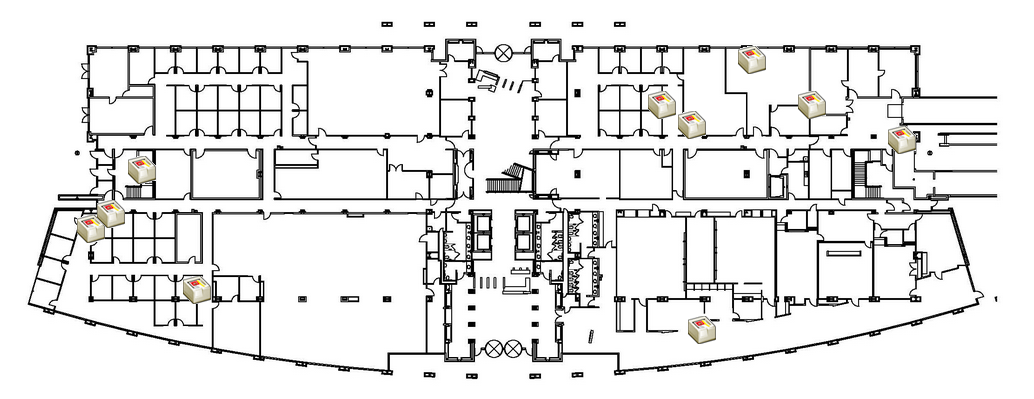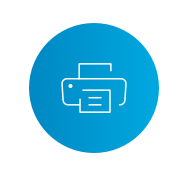The previous article discusses the new features in iPrint 2. But how is iPrint actually being used in practice? There have been many deployments that I have been involved with over the past few years. I thought that I would pick a few examples to give you an indication of how some organisations are implementing the appliance to resolve specific printing issues within their environments. Hopefully this will enable you envision how you could use iPrint in your organisation.
A Standard desktop printing environment
This is the environment that the vast majority of customers use iPrint in, and indeed how we use it internally. OES has shipped with iPrint desktop printing for many years and this enables users to do what is termed Self service printing.
A user can walk into any office in the world bring up the printer installation map for that location click on a printer, which will install it, and they will be printing within a few minutes (Figure 1).

This Self service printing is far less painful than having to find the printer driver and install it themselves, or wait hours (or days) for someone from the IT department to install it.
If you have OES under maintenance the desktop licences that you have with that can be used with the new iPrint 2 appliance and you can make use of the Walk up Printing capabilities.
Guest printing
A large, well known, media organisation in the UK added a new building to their campus hosting multiple meeting rooms. However they had a problem with guests attending meetings not being able to print documents.
To resolve the problem they implemented an iPrint appliance. Each printer in their environment has an email address assigned to it and guests can email print jobs directly to any printer.
As, in this case, we could not license this per user, which was going to be an unknown quantity, we used the per printer licensing option for iPrint.
Mobile Printing
I recently set up a proof of concept for a hotel chain who wished to improve checkout times at busy periods, especially at their large hotel located near London Heathrow Airport. As you can imagine, customers can become a little frustrated if it takes too long to check out of the hotel when you have a plane to catch and you have overslept!
They have employees travelling the checkout queue with iPads confirming the invoice with the customers and then printing it, thus reducing time at the desk and providing a far faster, and efficient, checkout experience to their customers than they have in the past.
Secure external printing
At the end of last year I set up a proof of concept for a large charity in the Netherlands who had a requirement for users to be able to print to any of 600 or so printers scattered in offices around the country. The only trouble was that the users would be external and needed to print from outside the secure network. They were using Windows laptops and mixture of mobile devices such as iPads and Android tablets and phones.
The customer has an existing Windows print environment, that they were not keen on removing as internal printing was done through this and the existing desktop and internal machines were configured to go through this.
So both the iPrint and Windows printing environments needed to run side by side. To make the printing easier we decided to use an iPrint feature to submit print jobs to the existing Windows print server.
We set up an iPrint appliance in the DMZ with the capability to communicate securely with the clients over SSL, and with communication to the internal LDAP server and existing Windows print server.
All external users can securely connect to the Appliance and print, not only with the mobile application, but also with the desktop client. There is an authentication mechanism which enables only authorised users to submit print jobs.
Smart card printing release
A local housing group in Scotland needed to have Mobile iPrint integrated into their existing Ricoh secure desktop printing environment, where they were using smart cards to pull print jobs down to the printer.
In this instance we had iPrint send the print job to the existing Windows print server, rather than directly to the printers themselves. This allowed the secure printing system to pick up the mobile print job and treat it much the same as if it came from a desktop.
An advantage of this is that the details of the user submitting the print job is passed on, along with the print job, into the print queue by the appliance. This allowed users to print from their mobile device, then walk up to a printer use their smart card and pull their print job down to that specific printer.
Accounting and costing
A university I visited recently had a requirement to charge students for their printing, as many such establishments do. Although there are some accounting options within iPrint, they are not always extensive enough for doing the type of charging that users require..
However we can integrate with third party solutions to provide the required functionality.
In this case the university used a product called Papercut (www.papercut.com) which does have an option to be installed on the iPrint appliance itself. The appliance has an option to pass accounting details through to Papercut so students, and staff, can be charged correctly for their printing.
We can also integrate into a number of other printing solutions, for instance Equitrac.
Licensing
It is most probably worth mentioning how iPrint is licensed. It is typically licensed per user, who can be licensed for Desktop, Mobile or what is termed Enterprise, which in reality is both Desktop and Mobile.
There is also an option for it to be licensed per printer rather than user, which is best used in environments where the number of users is unknown, for instance in the case above where you may have visitors who wish to print, or at a hotel where there are an unknown number of guests.
Remember if you have Open Enterprise Server (OES), Novell Open Workgroup Suite (NOWS) or NOWS Small Business (NOWS SB) you are entitled to use your existing desktop licenses with the iPrint appliance, which will allow you to use the Follow Me printing capabilities.
If you are planning to run mobile devices against this you will need to purchase the appropriate Mobile or Enterprise licenses.
Try it
Having learnt all about how people are using iPrint, do you now want to try it out? If you have any mobile devices in your environment, then I would suggest downloading the evaluation and give it a go. It is available on download.novell.com with a 60 day license.
Have fun, I am sure your users will love it.
This article was first published in OHM, Issue 33, 2016/2, p7-8.

